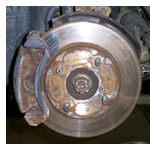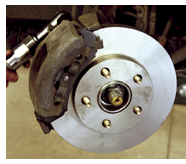Cross-Examining Service Adviser:
“May I help you?”
Customer:
“Yes, I need to get a brake job.”
Service Adviser:
“OK, sign here and we’ll get right to it.”
The technician pulls the vehicle in and finds that the pads are low. The brake job is already authorized over the front counter. The tech does the job, test-drives the car, parks it, the customer pays and leaves.
 Does that sound about right? Well, pretty close anyway. The customer needed a brake service, he got one, and he left. The shop is happy because a profit was made and the customer is happy because he got what he wanted. But could everyone be happier? Possibly.
Does that sound about right? Well, pretty close anyway. The customer needed a brake service, he got one, and he left. The shop is happy because a profit was made and the customer is happy because he got what he wanted. But could everyone be happier? Possibly.
Perhaps something extra could have been done that could have increased the shop’s profits and/or increased the customer’s satisfaction. Perhaps the service adviser (SA) could have asked a few questions and provided some actual service advice to the customer, rather than just taking the customer’s order.
Let’s try it again.
Service Adviser:
“May I help you?”
Customer:
“Yes, I need to get a brake job.”
Service Adviser:
“You certainly came to the right place.” (smile) “What kind of problem are they giving you?”
Every customer who comes through your front door is driven by some kind of motivation to be there. People don’t shop for auto repair just because they are bored. They come in because they feel they have to, and the first thing the SA should do is find out why they feel that way. The customer’s answer can lead to multiple different courses of repair action at this point: “They make a lot of noise;” “They shake when I come to a stop;” and “They don’t stop very well,” “The brake light has been coming on.”
Now that a problem has been indicated by the customer, the SA needs to ask the customer how to duplicate the concern so that the technician knows how to make the problem occur and/or determine if it may be a normal characteristic.
Service Adviser:
“Does it do it every time you come to a stop?”
Customer:
“Yes, every time;” “Only when I go down an exit ramp;” “Only during the first stop or two in the morning;” or “Only in stop-and-go traffic.”
Sometimes the SA needs to ask a leading question to target some rather important information.
Service adviser: “Have you noticed any pulling to the left or right when you apply the brakes?”
It seems like customers forget to mention that one unless they are directly asked. I assume it’s because they get used to it over time and anticipate it when coming to a stop.
Therefore, they sometimes dismiss it and don’t think about it later to talk about it. Or, they just assume that it will be corrected during a brake job.
It’s also good if the technician knows the related history. If the vehicle is low mileage then he should ask, “Has the vehicle ever had a brake job before?” If the vehicle is higher mileage then ask, “When was the last time it’s had a brake job?”
Either way of asking the question should prompt the information you are looking for from the customer: “No, first time”; “It’s been a couple of years”; or a red flag answer of “About a year ago (or less).” If the brakes won’t last a year, the technician should be aware of this during his inspection.
One question that no SA should ever forget to ask is: “Do you know if your car uses a special key for the lug nuts or hub cap?” If the customer says “yes,” then the SA needs to inquire as to where it is located. The game of wheel key hide-and-go-seek loses its fun during the third unsuccessful search.
 After the vehicle inspection and it is time for the sale, the customer should be asked a few more questions. For example, if your shop offers dusting pads and/or add-on dust shields for behind the wheels, you should inquire about the customer’s concern for the dust. “Would you like to reduce or possibly eliminate the dust on the wheels?” That is a great chance for, not only an up sell, but a customer can start to appreciate the benefits that you offer nearly instantly.
After the vehicle inspection and it is time for the sale, the customer should be asked a few more questions. For example, if your shop offers dusting pads and/or add-on dust shields for behind the wheels, you should inquire about the customer’s concern for the dust. “Would you like to reduce or possibly eliminate the dust on the wheels?” That is a great chance for, not only an up sell, but a customer can start to appreciate the benefits that you offer nearly instantly.
If the vehicle happens to be a full-size truck or SUV, the SA should also inquire about the vehicle’s usage. “Do you haul heavy loads or tow often with the vehicle?” If the answer is “yes,” then suggesting a severe-duty pad may serve your customers’ needs better. Just be sure to advise them that they might hear some squeaking noises from a severe-duty pad due to the higher iron content in the pad.
If the vehicle is a performance car, the SA can also ask: “Would you like me to upgrade the brake rotors to a high-performance brake rotor?” If the brake rotors that are on the vehicle can be resurfaced, be sure that the customer understands that. Make it clear that a replacement at this point would only be for a performance upgrade to some drilled and slotted rotors to reduce the brake temperature and potentially increase braking performance, and this is not a requirement of the service. It is only a suggested option.
If you offer a longer-life brake pad, ask the customer: “Are you satisfied with how long these pads have lasted?” Don’t make any wild promises to anyone about this, and be sure to explain any downside involved with a harder pad, such as possibly squeaking.
A little customer interrogation will not only open the door to some modest up-sales to a brake service, it will also allow you to custom-tailor the service to the customer’s needs. The customer and the shop are both happier in the end. It is a “win-win” situation.












